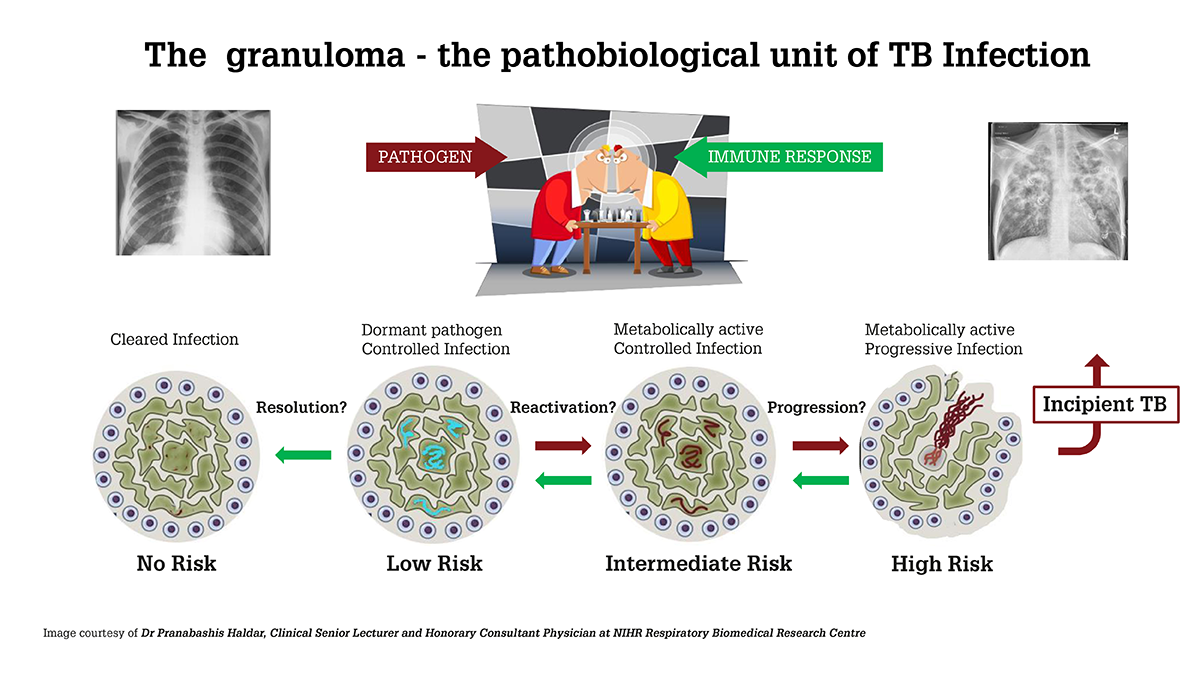Bacteriophage Boost for TB Management
Are phage-based diagnostics the next big thing in the fight against tuberculosis?
Although collaborative efforts between non-government organizations and commercial entities are being formed to accelerate the development of new drugs to treat tuberculosis (TB) amid growing resistance, there is also a need for new diagnostics to identify individuals at risk of disease. But the causative pathogen – Mycobacterium tuberculosis (Mtb) – is a master of disguise and can remain hidden within the host for many years.
It is estimated that up to one quarter of the world’s population may have latent TB infection without developing any illness; 5–10 percent of this group will have progressive infection that eventually develops into active TB. Currently, it is difficult to identify those with latent TB who will progress to pulmonary TB – a disease that causes significant lung damage and can, without treatment, be fatal.
The evolving spectra of TB
It has long been known that Mtb can spread through the air when an infected person coughs, sneezes, speaks, sings, or laughs. The protective immune response acts to contain the infection to the lung or local lymph nodes; however, we have recently come to understand that Mtb may spread internally from the lungs into the bloodstream and other organs.
The immune system has two phases. First, the innate immune response stimulates alveolar macrophages, which ingest the mycobacteria to kill it; however, this is usually ineffective because the organism is so well adapted to humans. T cells are then activated, which move to the site of infection and induce an adaptive immune response, leading to the development of mature granulomas.
Trapped within the granulomas, the immune response and the pathogen battle it out. The pathogen tries to replicate and leave the granuloma to cause progressive infection, while the immune response attempts to destroy it. If the Mycobacteria overcomes the immune response, the granuloma starts to break down – allowing the organism to escape. This is traditionally through the airways, and, in those that are severely immunocompromised, it was recognized that bacteria can also escape into the bloodstream. Cell-free bacteria can translocate into the capillary network surrounding the lung or bacteria taken up by macrophages that are not immediately killed can be transported intracellularly in the bloodstream. The presence of Mtb in the blood could therefore be an indication of disease progression.
But how do we predict disease progression? A promising new type of bioindicator for bacterial infection is emerging that identifies the organism in a blood sample. It uses bacteria’s naturally occurring enemy – a phage – to hunt down live bacteria and lyse them, allowing the DNA to be identified with qPCR.
Benefits of phage-based diagnostics
Bacteriophages are viruses that infect bacterial cells. They are highly specific, with each phage preying on a single type of bacteria. The bacteriophage infects a bacterium and uses its own genomic machinery to replicate itself. This leads to lysis of the bacteria, breaking down the thick cell wall and releasing the phage and bacterial DNA, which can then be used for analysis.
There are several phage-based diagnostics for Mtb in development, but most are confined to sputum or liquid cultures. It is difficult for children and immunocompromised individuals to bring up sufficient sputum for analysis, so there is a need for a molecular diagnostic that can determine Mtb in the blood – providing a simple, effective way to screen at-risk populations.
Recently, we’ve been putting a phage-based assay to the test to see whether it can accurately detect TB disease and predict progression.
Clinical study (1): Can a phage-based test detect bacteria in the blood of those with active TB?
At the University of Leicester, UK, we conducted two studies using a phage-based test. The first study investigated if the phage-based assay could detect bacteria in the blood of people with active pulmonary TB or people with incipient infection.
We recruited people with suspected disease and identified a cohort with microbiologically confirmed active pulmonary TB. A smaller cohort of people who presented to the clinic with non-TB acute respiratory illness was also recruited.
We then recruited household contacts of the active TB cohort, including those who were IGRA-positive (latent infection) and IGRA-negative as healthy controls. Neither group had active TB and were shown to be asymptomatic with normal chest x-rays. They were followed up for 12 months after the assessment, with chest x-rays at three-month intervals.
The phage test was performed before people started treatment, and we found that it was highly sensitive and specific for pulmonary TB; 11 out of the 15 people with pulmonary TB were positive with the phage assay. The phage-negative participants tended to have disease of limited extent with fewer symptoms and lower level of systemic inflammation suggesting that the infection was being controlled before they were seen in the clinic.
None of the people in the non-TB respiratory disease control group were positive on the phage assay. Somewhat surprisingly, three out of the 18 people we identified with latent infection were positive with the assay and, of particular interest, two out of those three people went on to develop TB after seven months. We could verify this because they were seen at three-month intervals and had no evidence of TB prior to that time point.
This suggests that detection of Mtb in the blood of people with latent infection may be an indicator of incipient TB and able to identify those who are likely to progress to full disease. This was a very intriguing observation, albeit in small numbers of participants.
Clinical study (2): Can a phage-based test indicate progressive TB infection?
Building on the first study, we conducted a second that explored whether or not Mtb detected in the blood by the phage assay was associated with progressive TB infection.
Only 5–10 percent of people with latent infection will develop TB, but if we were to use active TB as an endpoint for our study, we would need to recruit very large numbers. We overcame this by using PET-CT as a highly sensitive imaging tool to visualize the trajectory of infection; PET-CT provides highly detailed structural information that can detect changes in the lungs in people with TB infection, such as enlargement of the lymph nodes. Additionally, the PET scan enables measurement of metabolic activity at sites of infection.
We recruited a cohort of healthy household contacts of pulmonary TB patients. The contacts were all asymptomatic with normal chest X-rays. They underwent a PET-CT baseline scan and, if it was positive and showed metabolic activity that could be sampled, they went on to have a bronchoscopy and sampling. If this was positive for Mtb they were treated for either having early disease or being at high risk of TB.
If the baseline PET-CT scan did not show anything that could be sampled or if the sampling was negative for TB, they were monitored with a second PET-CT after three to four months.
By comparing the first and second scans, we were able to categorize people as:
- Stable; indicating no significant change in PET-CT appearance.
- Progressive PET-CT change (indicating progressive infection).
- Resolving PET-CT change (indicating resolving infection).
Those classified as stable or having resolving changes with no evidence of a positive mycobacterial culture were then observed for 12 months. Those with a progressive change were considered to be at high risk of developing disease and given treatment.
After the baseline PET-CT scan, four out of 20 participants had positive Mtb microbiology with sampling from regions of increased PET-CT activity and received treatment. For the remainder who went on to have a second PET-CT scan, two out of 16 contacts showed significant progressive PET-CT changes and were given treatment.
In total, we identified six people with potentially progressive latent TB infection who fit the criteria for incipient TB. All participants to the study had a baseline phage-based test, and we found a significant association between having a positive phage assay result at baseline and being subsequently identified with probable incipient TB. This correlation supports our observations from the first study that being positive on the phage test is a risk factor for progressive infection at risk of developing to TB.
Promising potential
When combined with qPCR methods, phage-based technologies offer a highly specific and sensitive approach to developing pathogen-directed markers of TB. The existing diagnostics for TB are inadequate to meet the minimum WHO target product profile thresholds to support disease elimination – proving that faster, more sensitive tests are required that do not rely on sampling sputum from the site of infection.
Host immune biomarkers can inform us of the presence of current or previous TB infection, but cannot discriminate between the two – nor do they tell us anything about the infecting pathogen. Only recently have we been able to demonstrate that Mtb is detectable in the blood of people with active or latent TB in the absence of immunodeficiency. (Historically, culture-based methods only detected Mtb in the blood of those with very severe illness.)
Using phage-based diagnostics, it is becoming increasingly possible to detect Mtb in the blood of a large number of people with TB infection – supporting future development of effective blood-based, pathogen-directed biomarkers that are low-cost, rapid, and potentially deployable in low-income settings. These biomarkers will likely reflect impaired pathogen containment within granulomas, which is thought to be the core basis for progressive TB infection.
Pathogen-directed biomarkers may complement current host immune markers for evaluating TB infection phenotypes, allowing us to discriminate between individuals who do – and potentially don’t – require treatment for their TB infection. This combination is a powerful tool to have in our arsenal, if we are to drastically reduce TB cases and deaths by 2030.
References
- R Verma et al., “A Novel, High-sensitivity, Bacteriophage-based Assay Identifies Low-level Mycobacterium tuberculosis Bacteremia in Immunocompetent Patients With Active and Incipient Tuberculosis,” Clin Infect Dis, 70, 5, 933 (2020). PMID: 31233122.
- JW Kim et al., “PET-CT-guided characterisation of progressive, preclinical tuberculosis infection and its association with low-level circulating Mycobacterium tuberculosis DNA in household contacts in Leicester, UK: a prospective cohort study,” Lan Micro (2024).






